Sagada’s Hanging Coffins in the Philippines, suspended on cliffs, encapsulates a centuries-old Igorot tradition rooted in spirituality. This cultural marvel, perched amidst preservation challenges, evokes curiosity and reverence. As visitors explore the historical origins and significance, they are captivated by a breathtaking testament to a unique burial practice.
In this blog post, we will explore the origins of the hanging coffins, their cultural and spiritual significance, preservation efforts and challenges, and how you can visit these remarkable sites for yourself. Get ready to delve into the wonders of the Hanging Coffins of Sagada. So, let’s begin our journey into this fascinating aspect of Filipino culture.
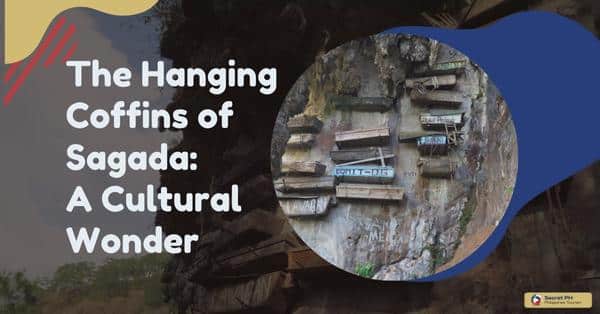
Historical Significance and Origins
The hanging coffins of Sagada are a remarkable cultural wonder that holds deep historical significance. These coffins, suspended high on the cliffsides and nestled amongst the lush greenery, are a testament to the ancient traditions and beliefs of the indigenous people of Sagada. The origins of this unique burial practice can be traced back centuries, with the Igorot tribes being the primary custodians of this tradition.
The hanging coffins serve as a tangible connection to the ancestors and their spiritual world. It is believed that by placing the coffins in elevated positions, the deceased are brought closer to the heavens, ensuring their spirits find their way to the afterlife.
This practice reflects the reverence and respect the community has for their ancestors, seeking to honor and preserve their memory in a truly distinctive manner. The hanging coffins of Sagada not only showcase the rich cultural heritage of the region but also provide a glimpse into the profound spiritual beliefs of the indigenous peoples of the Philippines.
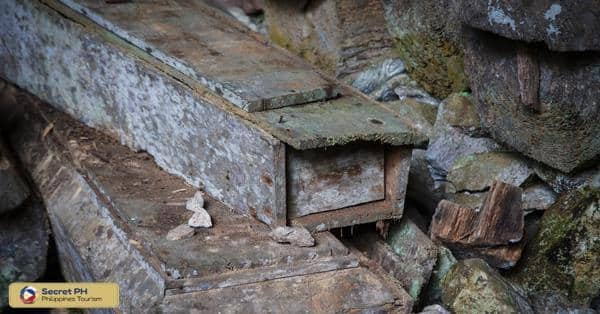
Cultural and Spiritual Beliefs
The hanging coffins of Sagada are not only a visual marvel but also hold deep cultural and spiritual significance for the indigenous Igorot people. Embedded within these suspended coffins are the cultural and spiritual beliefs that have been passed down through generations. For the Igorot community, the hanging coffins represent a connection to their ancestors and an expression of reverence towards the deceased.
The act of placing the coffins in elevated positions is believed to bring the departed closer to the heavens, ensuring a smooth transition to the afterlife. This belief reflects the deep spiritual connection that the Igorot people have with their ancestry and their commitment to honoring and preserving their cultural heritage. The cultural and spiritual beliefs surrounding the hanging coffins also serve as a unifying force within the community.
They provide a shared identity and sense of belonging, strengthening social ties and promoting a collective consciousness. Through the preservation and continuation of this burial practice, the Igorot people not only honor their ancestors but also reinforce their cultural traditions. The hanging coffins stand as tangible reminders of their cultural and spiritual beliefs, serving as a cultural wonder that captivates visitors and instills a sense of awe and appreciation for the rich heritage of Sagada.

Unique Burial Practices
Sagada’s hanging coffins are not only a testament to the Igorot people’s cultural and spiritual beliefs but also a striking example of unique burial practices that have endured for centuries. These hanging coffins are suspended on cliff faces, challenging conventional burial norms and offering a glimpse into the distinct customs of the Igorot community.
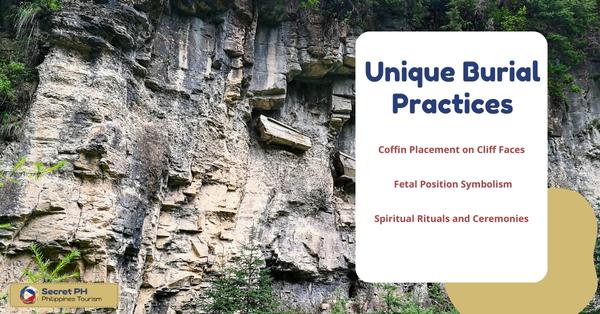
Coffin Placement on Cliff Faces
The most distinctive aspect of these burial practices is the act of suspending coffins from the sides of cliffs. Instead of traditional in-ground burials, the Igorot people hang their coffins on precipitous cliffs, sometimes at great heights. This unique approach symbolizes the Igorots’ aspiration to bring the deceased closer to the heavens, fostering a serene transition into the afterlife.
Fetal Position Symbolism
Another remarkable facet of these practices is the position in which the deceased are laid to rest inside the coffins. The Igorot tradition dictates that the deceased are positioned in a fetal posture, signifying rebirth and continuity in the spiritual realm. This position underlines their belief in the cyclical nature of life and death, reinforcing the connection between the living and the deceased.
Spiritual Rituals and Ceremonies
The placement of hanging coffins is not a mere physical act but a deeply spiritual endeavor. The Igorot people engage in elaborate rituals and ceremonies, including chants, offerings, and communal gatherings. These ceremonies emphasize the reverence they hold for their ancestors and the importance of maintaining a connection with the departed in the afterlife.
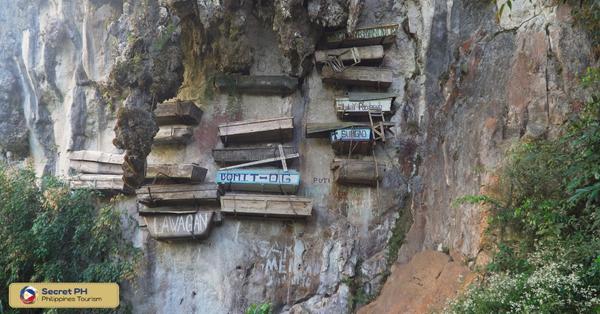
Preservation Efforts and Challenges
Preserving the cultural wonder of the hanging coffins in Sagada is an ongoing challenge in the face of modern influences and environmental threats. Efforts to safeguard this unique heritage are essential to ensure that future generations can continue to appreciate and learn from this remarkable tradition.
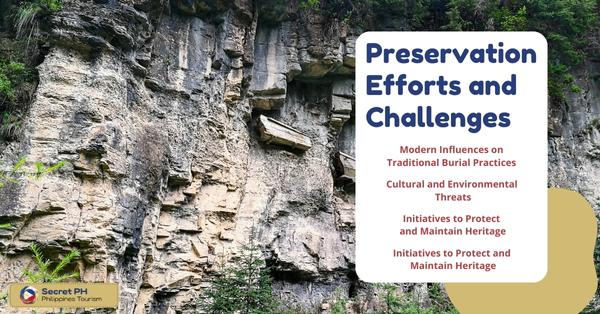
Modern Influences on Traditional Burial Practices
As modernization and external cultural influences seep into the Igorot communities, traditional burial practices like hanging coffins face the risk of fading away. Younger generations are increasingly drawn to more contemporary and convenient burial methods, posing a threat to the preservation of this age-old tradition.
Cultural and Environmental Threats
The natural environment plays a dual role in the preservation challenge. Harsh weather conditions, erosion, and the natural wear and tear on the hanging coffins pose a significant risk to their integrity. Additionally, there’s a growing concern about disrespectful visitors and looters who may damage or remove the coffins, compromising their historical and cultural significance.
Initiatives to Protect and Maintain Heritage
Recognizing the importance of safeguarding this cultural marvel, various initiatives and organizations have been established to protect and maintain the Hanging Coffins. Local communities, in collaboration with government agencies and cultural preservation groups, are working together to implement conservation measures. Such as reinforcing the cliff faces and restricting access to sensitive areas.
Responsible Tourism and Education
A crucial aspect of preserving the Hanging Coffins is educating tourists about their cultural and historical significance. Responsible tourism practices, including guided tours and visitor guidelines, help reduce the negative impact of tourism on the site while fostering an appreciation for the cultural heritage.
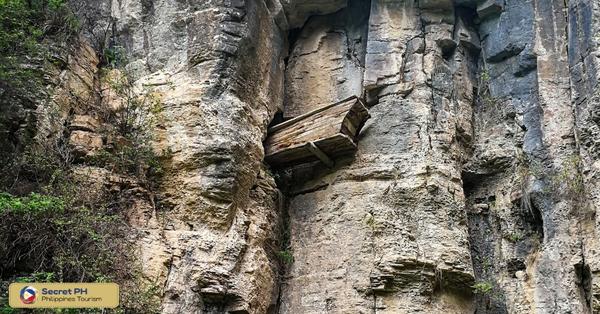
Tips for Visiting the Hanging Coffin
Visiting the hanging coffins is a remarkable journey into the cultural and spiritual heritage of the Igorot people. These ancient burial sites perched on cliffs are a unique cultural wonder. To make the most of your visit and show respect for this sacred place, here are some essential tips to consider:
Respect Local Customs: Remember that the hanging coffins are a sacred site. Show respect for the local culture, traditions, and customs, including maintaining a quiet and reverent demeanor.
Hire a Local Guide: Opt for a knowledgeable local guide to provide insights into the history, significance, and cultural context of the hanging coffins. Their expertise enhances your experience.
Stay on Designated Paths: Follow designated paths and trails to minimize the impact on the environment and to protect the integrity of the site.
Practice Responsible Tourism: Avoid littering, vandalism, or disturbing the natural surroundings. Leave no trace of your visit to ensure the site remains pristine.
Ask Permission for Closer Inspection: If you wish to take a closer look at the hanging coffins, ask for permission from your guide or local authorities. Climbing or touching them is generally discouraged.
Learn About the Rituals: Take the time to learn about the cultural and spiritual rituals associated with the hanging coffins. This enhances your appreciation of their significance.
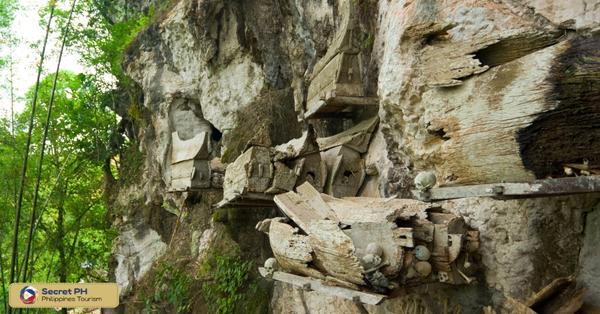
In conclusion
The Hanging Coffins of Sagada in the Philippines are not only a unique cultural wonder but also a significant link to the ancestral traditions and beliefs of the Igorot people. This intricate burial practice reflects their deep spiritual connection with their ancestors and reinforces their cultural identity. As visitors explore these suspended coffins, they are captivated by the historical origins, traditional customs, and spiritual beliefs encompassed within them.








